Your Cart is Empty
TALK TO AN EXPERT: Call, Text or Chat Mon-Friday 10AM-5PM CST [ 1-844-WILDOAK ]
Menu
-
- Berkey Water Filters
- Homesteading
- Composting Toilets
- DIY Shed Kits
- Barndominium Kit
- Garage Kits
- Chicken Coops
- Dairy Equipment
- Propane Wall Heater
- Harvest Right Freeze Dryers
- Water Filtration
- Greenhouse Kits
- Solar Fridge & Freezers
- Solar Generators
- Solar Panels
- Beekeeping
- Poultry Processing
- Dog Kennels
- Gazebo Kit
- Saunas
- Hunting Blind
- Compost Tumbler
- Drip Irrigation Kit
- Shade Cloth
- Living Off The Grid
- Off Grid Toilet
- Composting Toilets
- Incinerating Toilet
- Chicken Coops
- Greenhouses
- DIY Shed Kits
- Barndominium Kit
- Garage Kits
- Poultry Processing
- Dog Kennels
- BeeKeeping
- EMP & Signal Protection
- Emergency Food Kits
- Freeze Dryers
- Solar Generators, Panels and Batteries
- Solar Fridge & Freezers
- Propane Wall Heater
- Water Filtration
- Coolers and Cooking
- Gazebos
- Portable Sauna
- Camping Cot
- Hunting Blind
- Canvas Tents
- Prepping
- Overlanding Gear
- Composting Toilets
- Solar Generators
- Brands
- Chicken Coop Brands
- Composting Toilet Brands
- Solar Brands
- Food Storage Brands
- Freeze Dryer Brands
- Water Filtration Brands
- Incinerating Toilet
- Dry Flush Toilet Brands
- Waterless Toilet Brands
- Heater Brands
- EMP Shield Brands
- Tent Brands
- Cot Brands
- Cooler Brands
- Stove & Grill Brands
- Dog Kennels
- Greenhouse & Gazebo Brands
- Portable Saunas
- DIY Shed Kits
- About Us
- Resource Center
- The Ultimate Prepper & Emergency Survival Blog - Includes Free eBook
- Beginners Guide to Living off The Grid - Includes Free eBook
- Building Your Own Emergency Food Supply
- Best Survival Food to Be Prepared for Anything
- Berkey Lab Tests & Certifications
- Federal Solar Tax Credit - What You Need to Know
- BLOG
-
- 1-844-945-3625
- Login

TALK TO AN EXPERT: Call, Text or Chat Mon-Friday 10AM-5PM CST [ 1-844-WILDOAK ]
Best Freeze Dryer for Homesteading
by Patricia Turla 10 min read
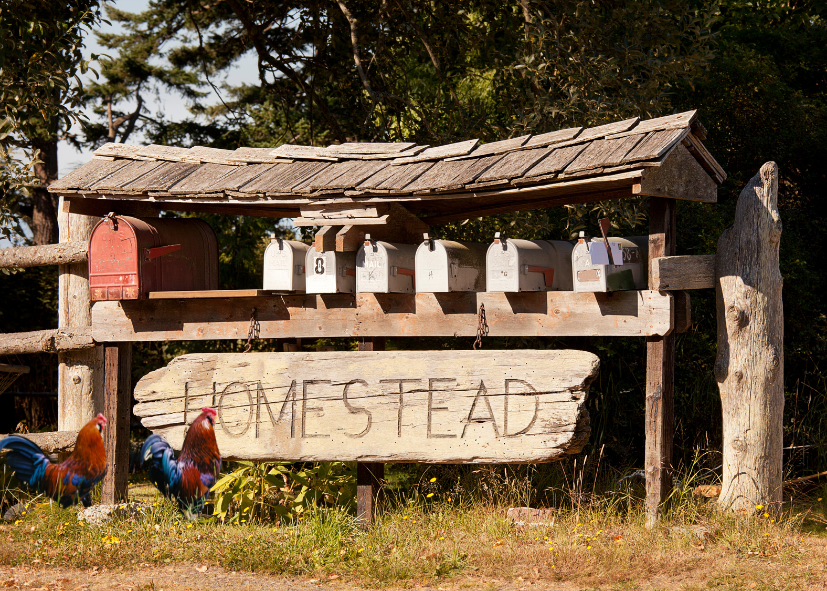
Remember back in the day when your parents or grandparents would spend hours over a hot stove, canning tomatoes and pickling every veggie that came out of the garden?Talk about labor-intensive! Nowadays, homesteaders have the much easier option of preserving through freeze-drying.
Freeze-drying helps make your home-grown fruits, veggies, and even raw and cooked meats shelf-stable for years to come. And the best part?You can do it all from the comfort of your own home with a quality Harvest Right Freeze Dryer.
Summary
What is Homesteading?
Homesteading is a lifestyle focused on self-sufficiency, sustainability, and a close connection to nature.
Food Preservation Methods for Homesteaders
Homesteaders preserve food using traditional methods like canning, pickling, drying, and root cellaring, as well as modern techniques such as freeze drying.
Benefits of Freeze Dryers for Homesteading
Freeze dryers offer long shelf life, retain nutrients, provide versatility in preserving various foods, reduce waste, and are user-friendly with modern features like touchscreen interfaces.
Choosing the Best Home Freeze Dryers
Consider factors like capacity, energy efficiency, ease of use and maintenance, cost versus value, warranty, and support when selecting a freeze dryer for homesteading.
Harvest Right Freeze Dryer for Homesteads
Harvest Right offers freeze dryers in different sizes suitable for various homestead needs, featuring user-friendly interfaces, efficient temperature control, and options for oil-free pumps.
What is Homesteading?
Homesteading is a lifestyle that emphasizes self-sufficiency, sustainability, and living off the land. Historically, the term dates back to the Homestead Act of 1862, when the U.S. government offered 160 acres of public land to anyone willing to farm and improve it for at least five years. Today, it’s less about acquiring land and more about living a life that emphasizes resourcefulness, independence, and a close connection to nature.
Motivations for Homesteading
Many people turn to homesteading for various reasons, such as:
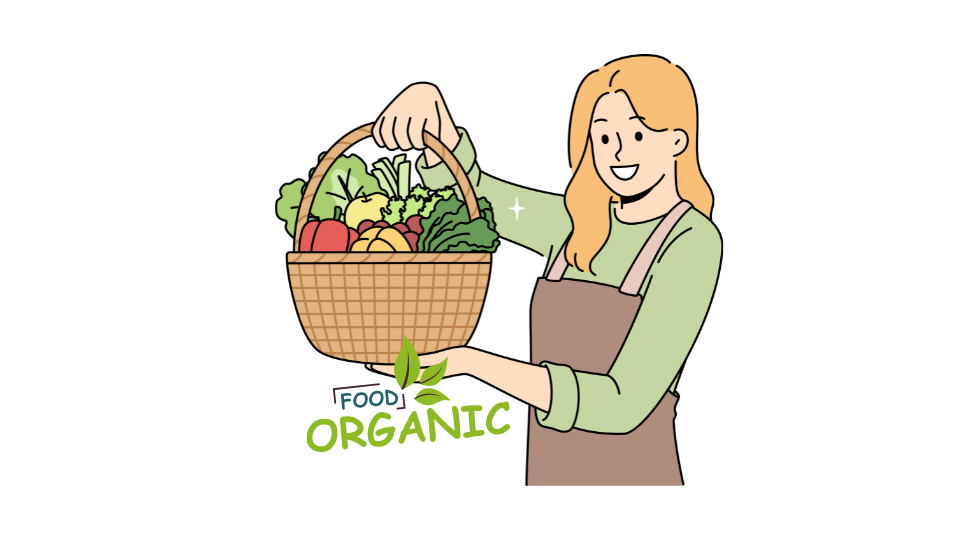
Health and Quality of Life Improvements
By growing your own food, you have access to fresh, organic produce that is often more nutritious than store-bought alternatives. The physical labor involved in gardening, tending to animals, and maintaining a homestead provides regular exercise, which can improve physical health and reduce stress.
Beyond physical health, homesteading can enhance mental well-being. The slower pace of life, closer connection to nature, and the satisfaction of completing tangible, meaningful tasks can boost overall happiness. Many homesteaders report feeling a greater sense of purpose and contentment, which is often lacking in more conventional lifestyles.

Environmental Effect Reduction
Growing your food locally cuts down on the carbon emissions associated with transporting produce from farm to table. Homesteaders often use sustainable farming practices that enrich the soil and promote biodiversity, which can help combat the negative effects of industrial agriculture.
Moreover, homesteaders tend to be more mindful of their waste. Composting kitchen scraps, recycling, and reusing materials are common practices. Some even strive for a zero-waste lifestyle, which significantly reduces the amount of trash that ends up in landfills. Renewable energy sources, such as solar or wind power, further decrease reliance on fossil fuels, contributing to a cleaner, healthier planet.
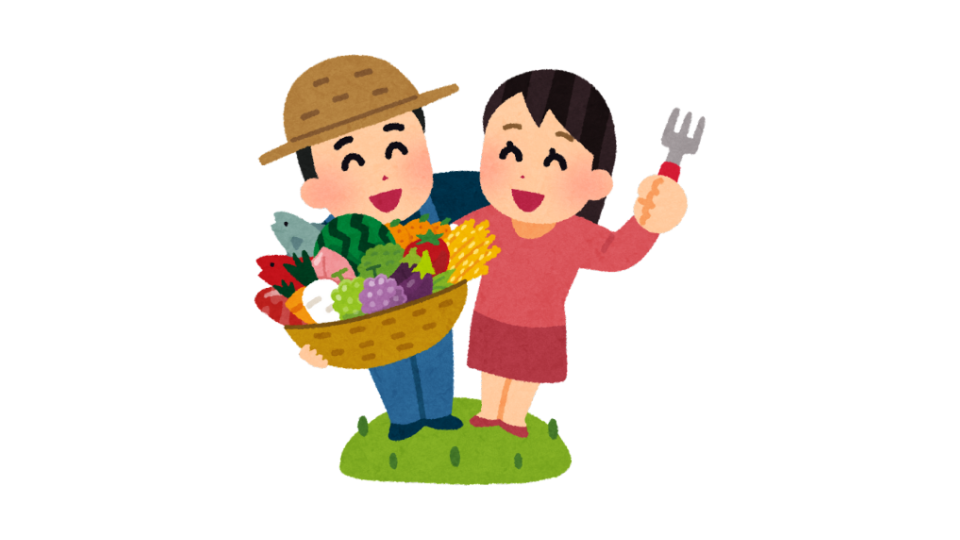
Self-Sufficiency
Homesteaders strive to produce as much of their own food, energy, and goods as possible. Not only does it drive for self-reliance, but it is also about building a lifestyle that is less dependent on external systems.
Many also adopt permaculture practices, which aim to create agricultural systems that are sustainable and self-sufficient. These practices can include everything from composting and rainwater harvesting to renewable energy sources like solar panels.
Food Preservation Methods for Homesteaders

When it comes to preserving homestead harvest, there are countless methods ranging from age-old traditional techniques to modern, high-tech solutions.
Canning
Canning is a time-tested method for preserving food by sealing it in airtight containers. This technique involves placing foods in jars or cans and heating them to a temperature that destroys microorganisms and inactivates enzymes. Properly canned food can last for years without refrigeration, making it a go-to method for preserving fruits, vegetables, and even meats. The process of canning can include both water bath canning and pressure canning, depending on the acidity of the food.
Pickling
By immersing foods in vinegar or brine, pickling not only enhances flavor but also extends the shelf life of various fruits and vegetables. The acidic environment prevents the growth of spoilage microorganisms, allowing pickled foods to be stored for months. Picking is particularly popular for cucumbers, onions, and peppers, offering a tangy, flavorful way to enjoy your garden harvest long after the growing season ends.
Drying
Drying is one of the oldest methods of food preservation. By removing moisture from food, drying prevents the growth of bacteria, yeast, and mold. Traditional drying can be done using sunlight, air, or a dehydrator. Dried foods, such as fruits, vegetables, and meats, become lightweight and shelf-stable, making them perfect for long-term storage.
Root Cellaring
Root cellaring takes advantage of the earth’s natural insulating properties to keep food at a stable temperature, extending its shelf life without the need for modern refrigeration. Usually, it is ideal for potatoes, carrots, beets, and other hardy vegetables that can last for months in the right conditions.
Fermentation
Fermentation is a fascinating and ancient technique that not only preserves food but also enhances its nutritional value. By allowing beneficial bacteria to convert sugars into acids, fermentation creates a hostile environment for spoilage organisms. Foods like sauerkraut, kimchi, and yogurt are popular examples of fermented foods.
Freeze Drying
Beyond traditional canning and drying methods, modern homesteaders often use freeze dryers. A home freeze dryer can preserve fruits, vegetables, dairy products, and raw and cooked meats.
The process of freeze drying involves pre-freezing the food and then using a vacuum pump to remove moisture. Freeze-drying results in freeze-dried food that is lightweight, shelf-stable, and retains most of its original nutritional value. Freeze-dried fruit and food are stored in mylar bags with oxygen absorbers to ensure they remain completely dry and safe for long-term food storage.
Benefits of Freeze Dryers for Homesteading
The following are the benefits of freeze-drying:
Long Shelf Life Expectancy
Canning is great and all, but those jars of apple pie filling are only good for a couple of years tops. Freeze-dried foods, on the other hand, can legitimately remain fresh and tasty for over two decades when stored properly in mylar bags with oxygen absorbers. The freeze-drying process, where food is frozen to extremely cold temperatures and then subjected to a vacuum that removes the ice crystals through sublimation, ensures a long shelf life most preppers only dream about!
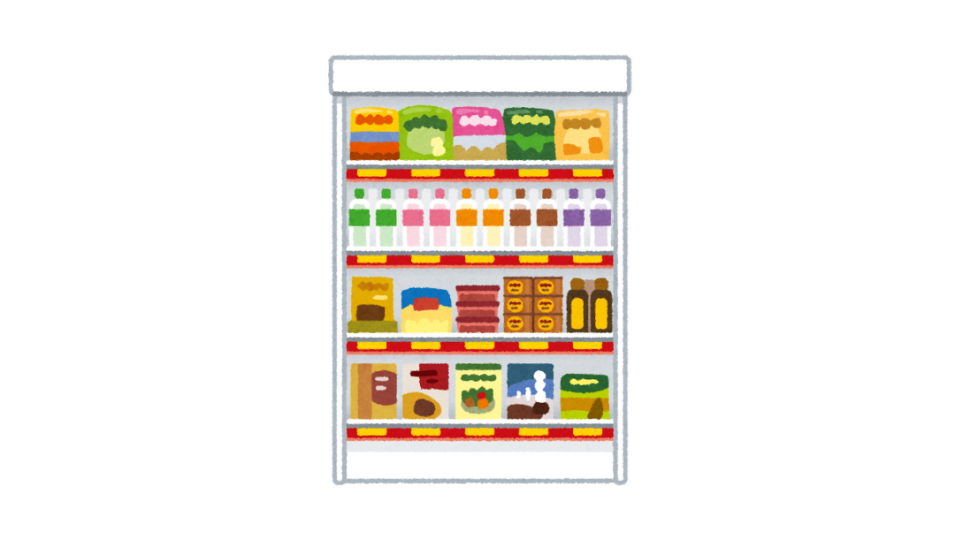
Nutrient-Packed
Unlike other preservation methods, freeze-drying retains the nutritional value, flavor, and texture of food exceptionally well. The drying process ensures that vitamins, minerals, and antioxidants remain intact, making freeze-dried fruits and vegetables almost as nutritious as their fresh counterparts.
The freeze-dryer operates by removing moisture while preserving the cell structure of the food, which means that once rehydrated, freeze-dried foods closely resemble their original state. Imagine enjoying a homemade stew or fresh berries that taste as if they were just picked, even years after they were initially preserved.
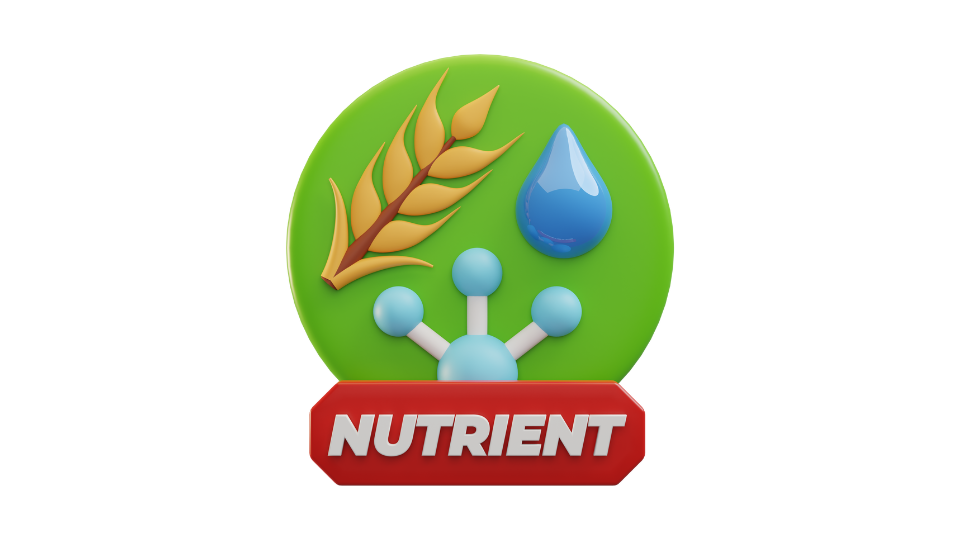
Versatility
From fruits like freeze-dried grapes and strawberries to vegetables, dairy products, and meats, the possibilities are virtually endless. Such versatility extends to both raw and cooked foods, allowing homesteaders to freeze dry entire meals or individual ingredients.
For example, you can freeze dry seasonal fruits and vegetables at their peak ripeness, making them available year-round. Meats, both raw and cooked, can be preserved to ensure you have protein sources on hand at all times. Dairy products like cheese and yogurt can be freeze-dried for convenient snacks or ingredients. And for those who enjoy cooking in batches, entire meals can be freeze-dried and stored for quick, healthy dinners on busy nights.
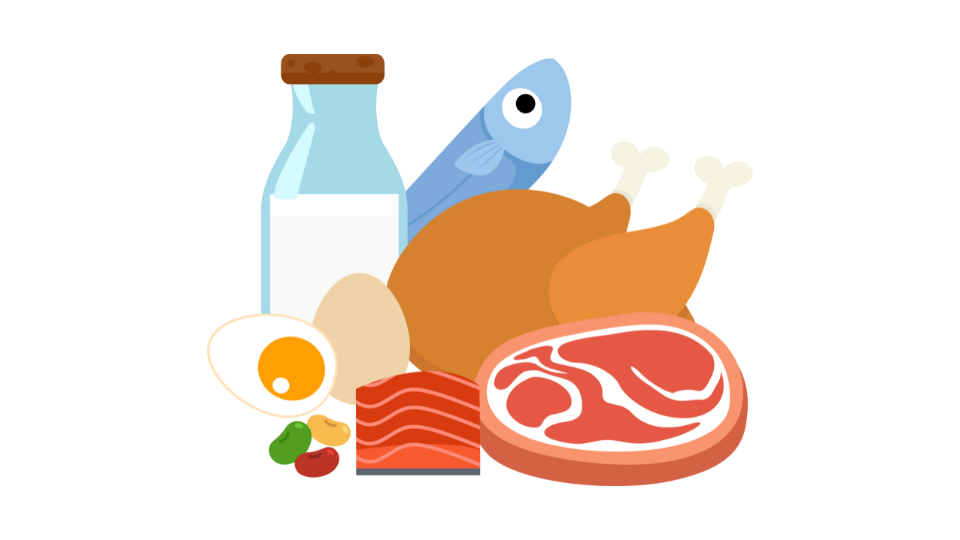
Reducing Waste
For homesteaders, who often deal with surplus harvests, a freeze dryer offers a way to preserve excess produce that might otherwise spoil. Instead of letting fruits and vegetables go to waste, you can freeze-dry them and enjoy them throughout the year.
Leftover meals can also be freeze-dried and stored, ensuring that no food goes unused. By turning surplus into shelf-stable dried foods, you can maximize the value of your harvest and save money in the long run. The process is easy: pre-freeze the food, load it into the freeze dryer unit, and let the machine do the rest.
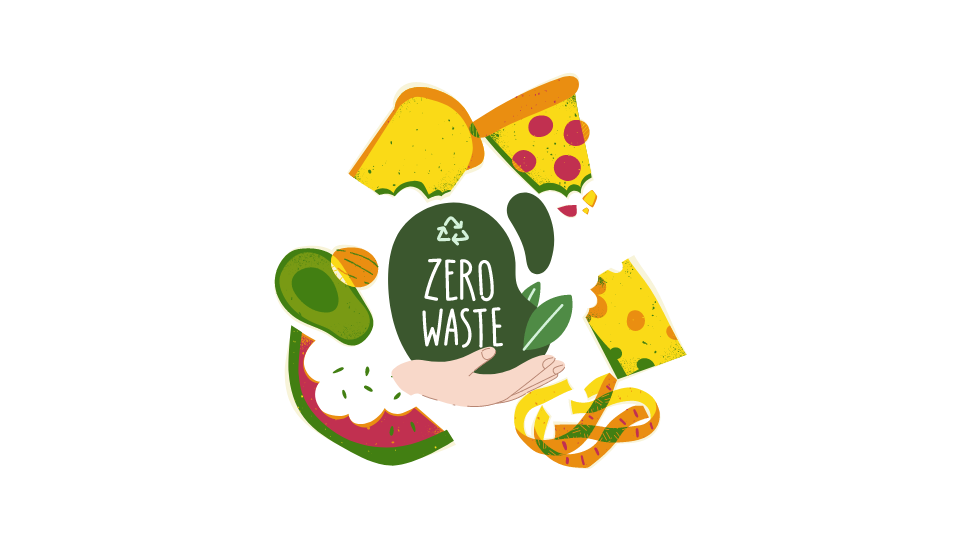
User-Friendly Operation
Modern freeze dryers, like the Harvest Right home freeze dryer, are designed for user-friendly operation with features such as touchscreen interfaces and easy-to-follow instructions. The efficiency of these machines, including those with oil-free pumps, ensures a smooth drying process that can handle multiple batches of food with minimal intervention.
For homesteaders, the investment in a freeze dryer is well worth it, given the long-term benefits. The freeze-dryer cost can be offset by the savings on food and reduced waste. Additionally, the maintenance of these machines is relatively simple, often requiring only periodic oil changes and proper ventilation to ensure optimal performance.
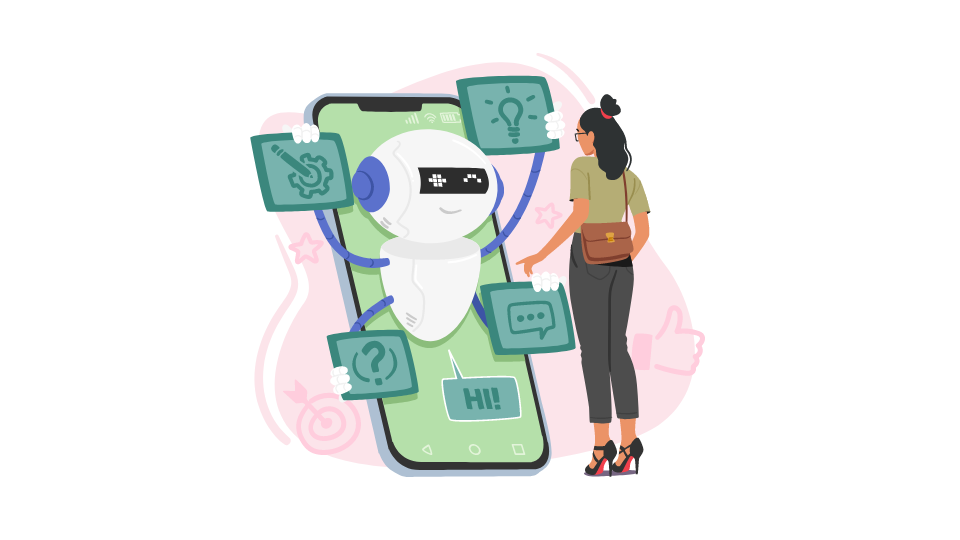
Choosing the Best Home Freeze Dryers

Selecting the right freeze dryer involves balancing various factors based on your specific needs.
Capacity and Size
When selecting the best freeze dryer for homesteading, capacity and size are necessary. Home freeze dryers come in various sizes, from small units perfect for smaller families or those with limited space to larger models ideal for those with substantial harvests or larger families. Consider the tray space and how much food you plan to freeze dry in each batch. A medium unit might be sufficient for many, offering a balance between capacity and footprint.
Energy Efficiency
Freeze dryers can consume a considerable amount of power, especially during the drying process, which involves maintaining extremely cold temperatures. Look for models that operate within the most efficient and recommended temperature range to save on electricity costs. An efficient operation not only saves money but is also environmentally friendly.
Ease of Use and Maintenance
User-friendly features like a touchscreen interface can significantly enhance your freeze-drying experience. Models with oil-free pumps require less maintenance compared to those with vacuum pump oil, which needs regular oil changes. Check the manufacturer’s instructions for recommended maintenance routines and ease of access for cleaning and upkeep.
Cost and Investment Value
Assess the cost and the long-term value they bring. While initial costs can be high, the ability to preserve large quantities of food, reduce waste, and ensure food security can make a freeze-dryer worth the investment. Consider the freeze-dryer cost against potential savings from preserved food and reduced grocery bills.
Warranty and Customer Support
A good warranty is a sign of confidence from the manufacturer. Most reputable brands offer warranties that cover key components like the vacuum pump and control board. Customer support is also critical – having access to knowledgeable support can be invaluable for troubleshooting and getting the most out of your freeze dryer.
Harvest Right Freeze Dryer for Homesteads
When it comes to preserving food on your homestead, the Harvest Right Freeze Dryer stands out as a top choice on the freeze dryer market for the following reasons:
Specific Models for Homesteading
Harvest Right offers several models tailored to different needs and scales of operation, ensuring you find the right model to freeze dry food.

Small Unit
Perfect for those with a smaller garden harvest or for beginners. Compact, easy to use, and can handle batches of food that are just right for a small family.
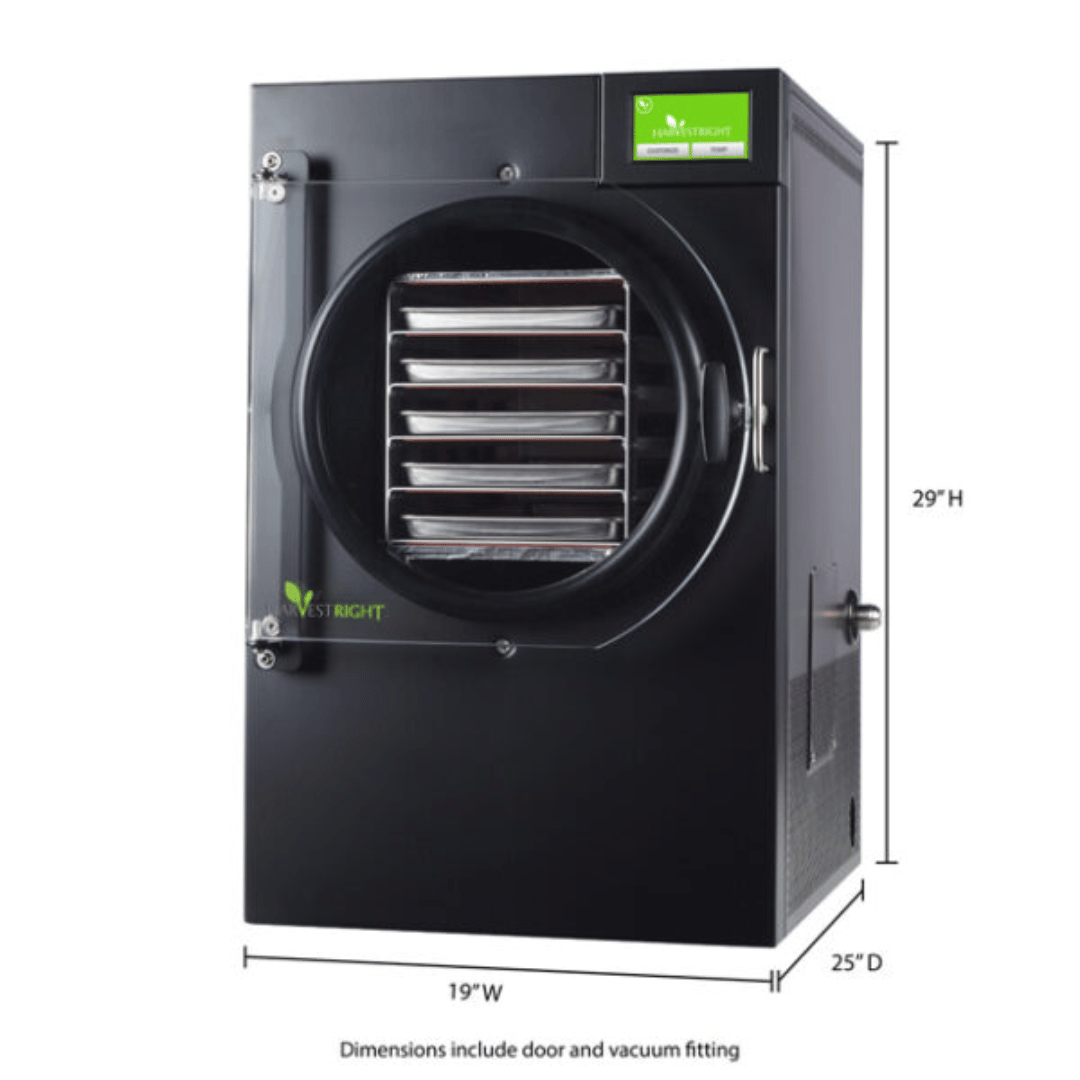
Medium Unit
Ideal for medium-sized homesteads, this unit strikes a balance between capacity and footprint. Versatile enough to manage a variety of foods, from fruits and vegetables to meats.
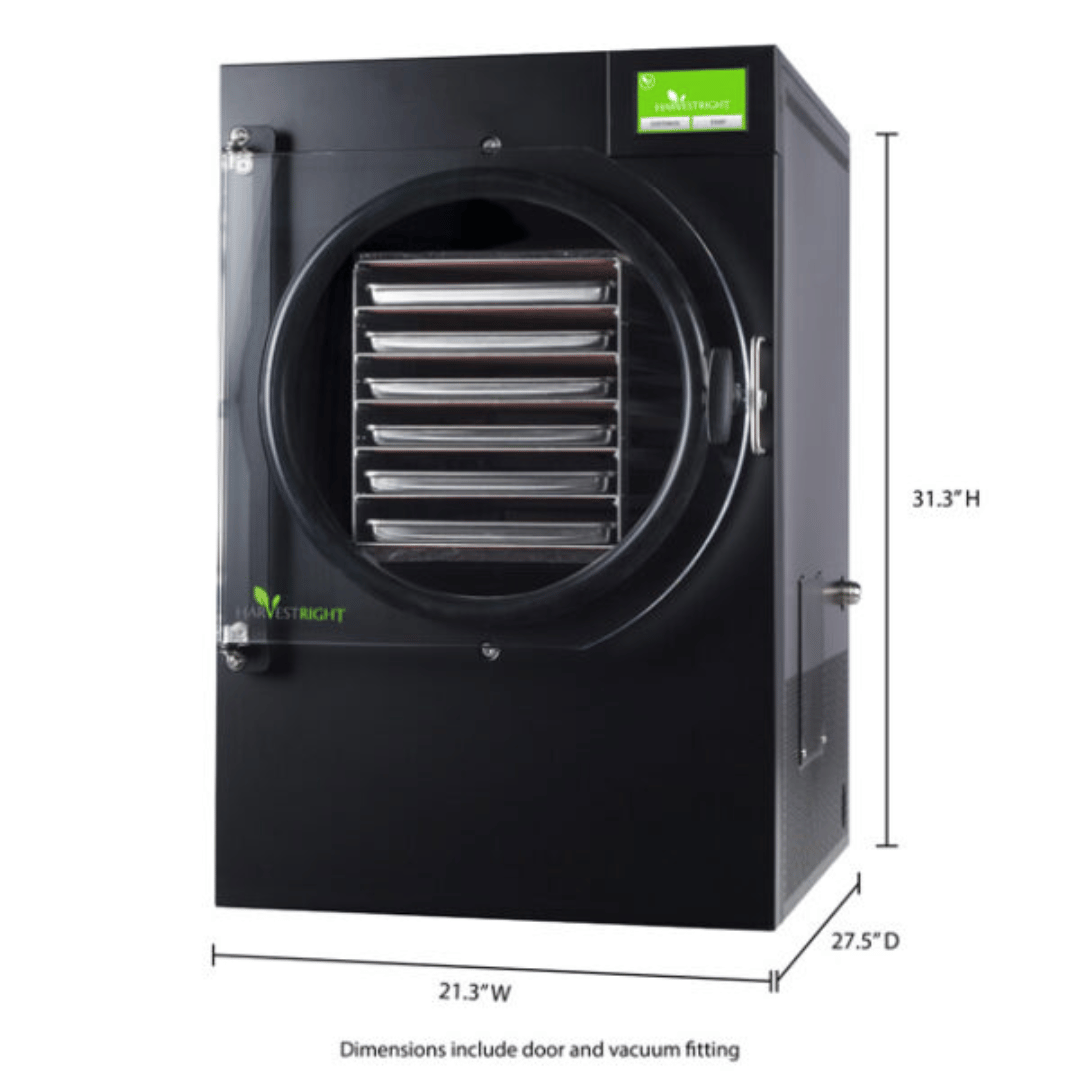
Large Unit
Best for larger homesteads or those who want to preserve significant amounts of food. With more tray space and a more powerful vacuum pump, it can handle full meals and large harvests efficiently.
Features and Benefits
Harvest Right freeze dryer comes packed with features that make it the best freeze dryer for homesteading.
User-Friendly Touchscreen Interface
The Harvest Right Freeze Dryer is equipped with an intuitive touchscreen interface, making the freeze-drying process a breeze even for beginners.
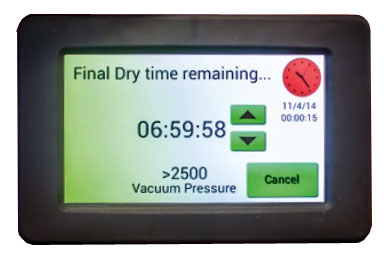
Temperature Range
Operating within the most efficient temperature range, the Harvest Right freeze dryer ensures that your food is dried at optimal temperatures. The efficient operation not only preserves the nutrition of your food but also maintains its taste and texture compared to canned or frozen food.
Oil-Free Pump Option
Traditional freeze dryers require regular oil changes, which can be a hassle. With the oil-free pump, maintenance is reduced, making the unit more user-friendly and cost-effective in the long run.
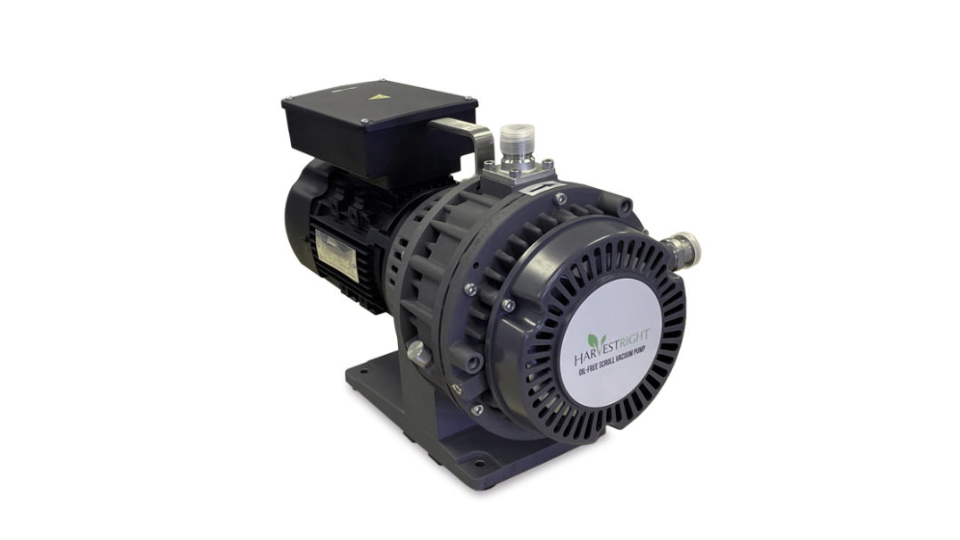
Spacious Trays for Larger Batch of Food
The Harvest Right freeze dryer comes with ample tray space, allowing you to freeze dry larger batches of food in one go. Preserving a small harvest from your garden or preparing whole meals for long-term food storage, the extra trays provide the flexibility you need to process more food efficiently.

Versatility in Food Preservation
From drying dairy products and gummy bears to full meals, the Harvest Right freeze dryer handles a wide variety of foods.
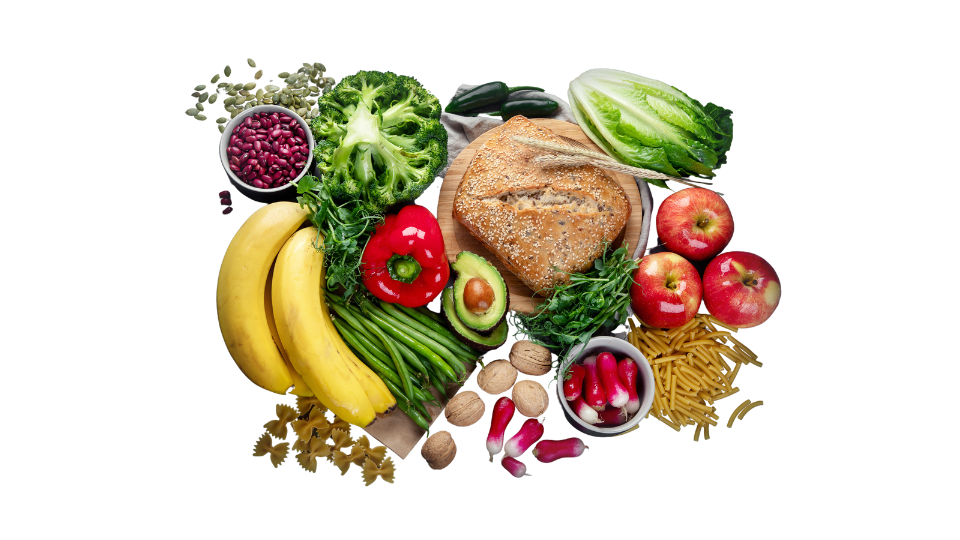
Extended Shelf Life
Freeze drying extends the shelf life of your food. When stored in Mylar bags with oxygen absorbers, freeze-dried food can last for decades. Having long-term food storage ensures you have a reliable food supply in case of extreme heat, power outages, or other emergencies.
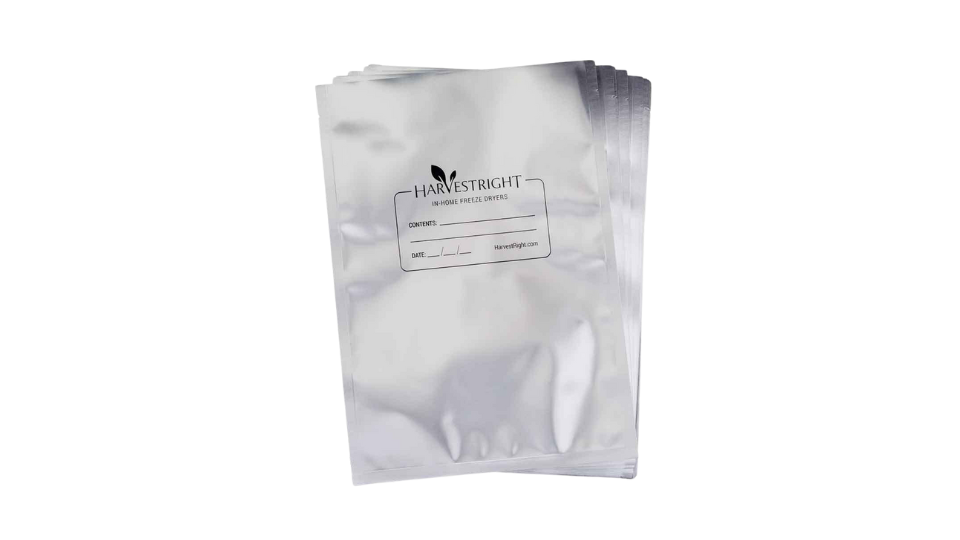
The Freeze Drying Process
The process involves three main stages: freezing, primary drying (sublimation), and secondary drying (desorption).
-
Freezing: In the freezing stage, the food is frozen at extremely freezing temperatures, usually between -30°F to -50°F. This initial freeze solidifies the water content in the food.
-
Primary Drying (Sublimation): During the primary drying phase, the temperature rises slightly, and a vacuum pump is activated to create a low-pressure environment. In this vacuum, the ice crystals in the food sublimate, turning directly into vapor without passing through a liquid phase. The drying process removes about 95% of the water content.
-
Secondary Drying (Desorption): The final stage, secondary drying, removes any residual moisture by further raising the temperature under vacuum. The food is now completely dry, retaining its structure, flavor, and nutritional content.
Tips for Efficient Operation

To get the most out of your Harvest Right freeze dryer, consider the following tips:
-
Proper Ventilation: Ensure your freeze dryer has adequate ventilation to operate efficiently.
-
Regular Maintenance: Follow the owner’s manual for maintenance, especially if using a unit with an oil vacuum pump.
-
Batch Processing: Freeze dry in batches to maximize efficiency and reduce the overall freeze-drying time.
-
Store Food Properly: Use Mylar bags and vacuum seal to store freeze-dried food and extend its shelf life.
Conclusion
Homesteading is a commitment to self-sufficiency, sustainability, and health. The economic benefits, coupled with the ability to reduce environmental impact, make it an attractive option for many. Tools like the Harvest Right freeze dryer for homesteading offer an efficient and eco-friendly way to preserve food. As the homesteading movement continues to grow, the integration of modern technologies like home freeze dryers will undoubtedly enhance the experience, making it more accessible and rewarding for all.

Have any questions or would like to place an order? We'd love to help! Chat with our friendly customer service team by calling 1-844-945-3625, chatting in on our website or email us at customersupport@wildoaktrail.com. We look forward to hearing from you!
Leave a comment
Comments will be approved before showing up.
